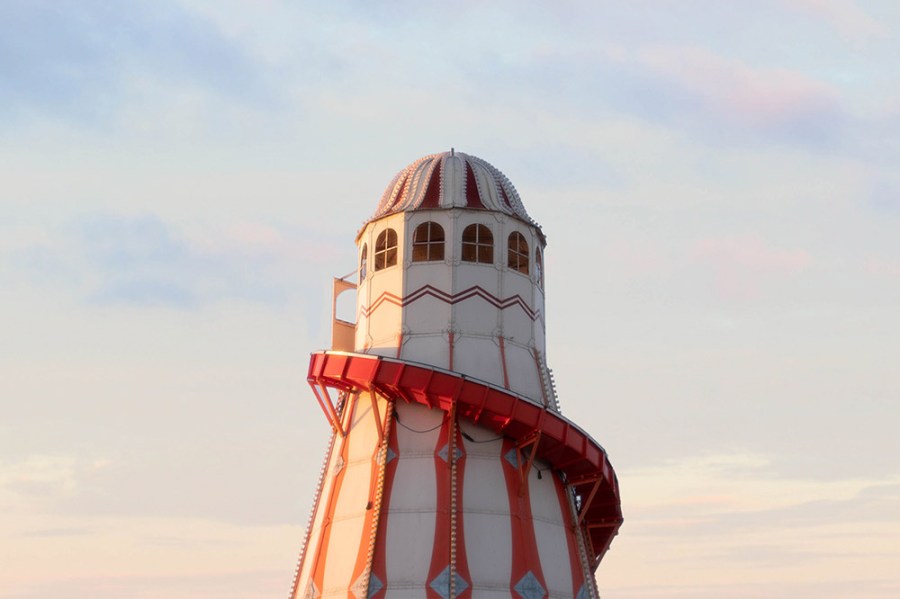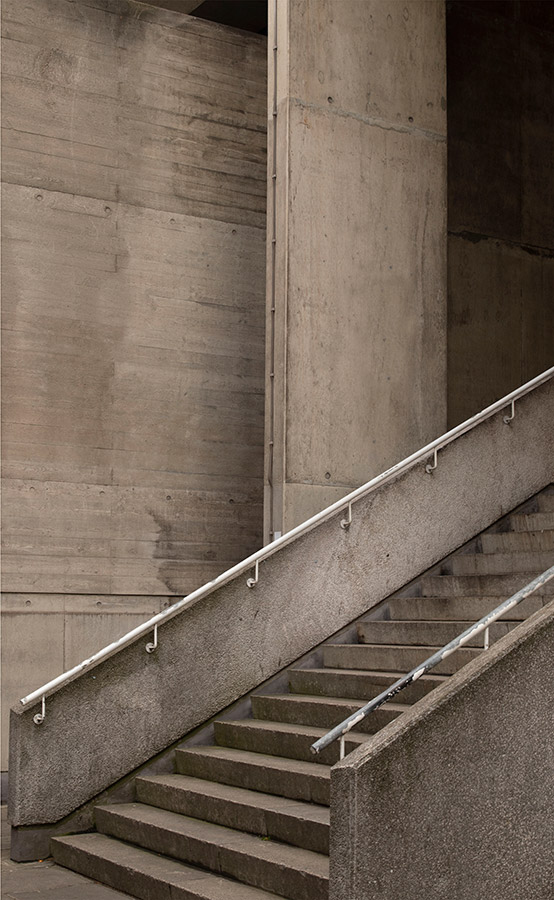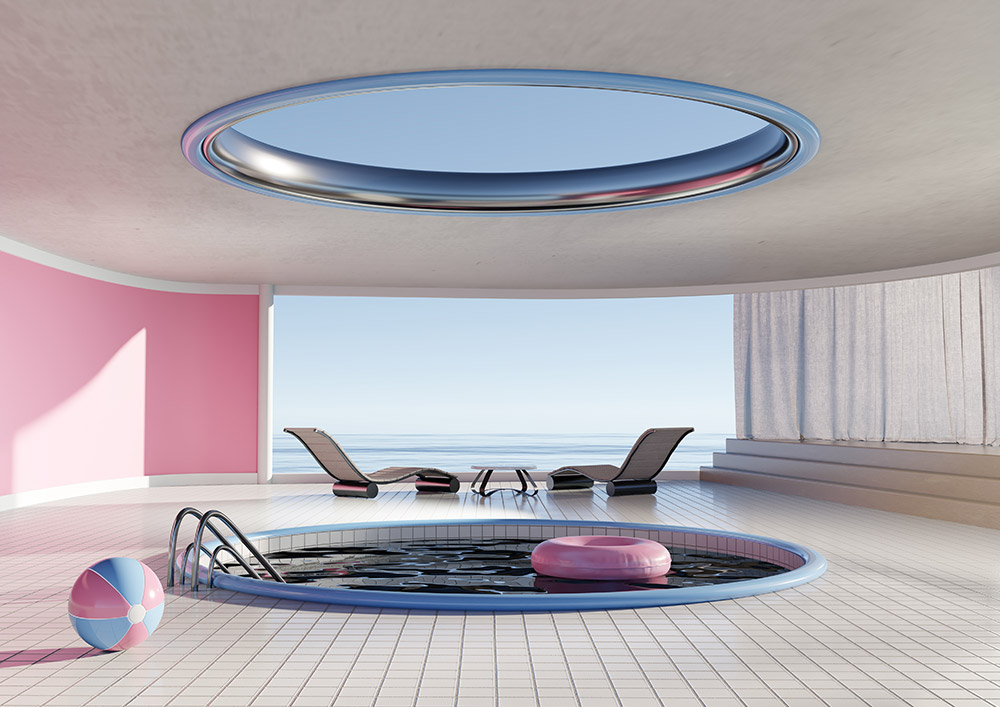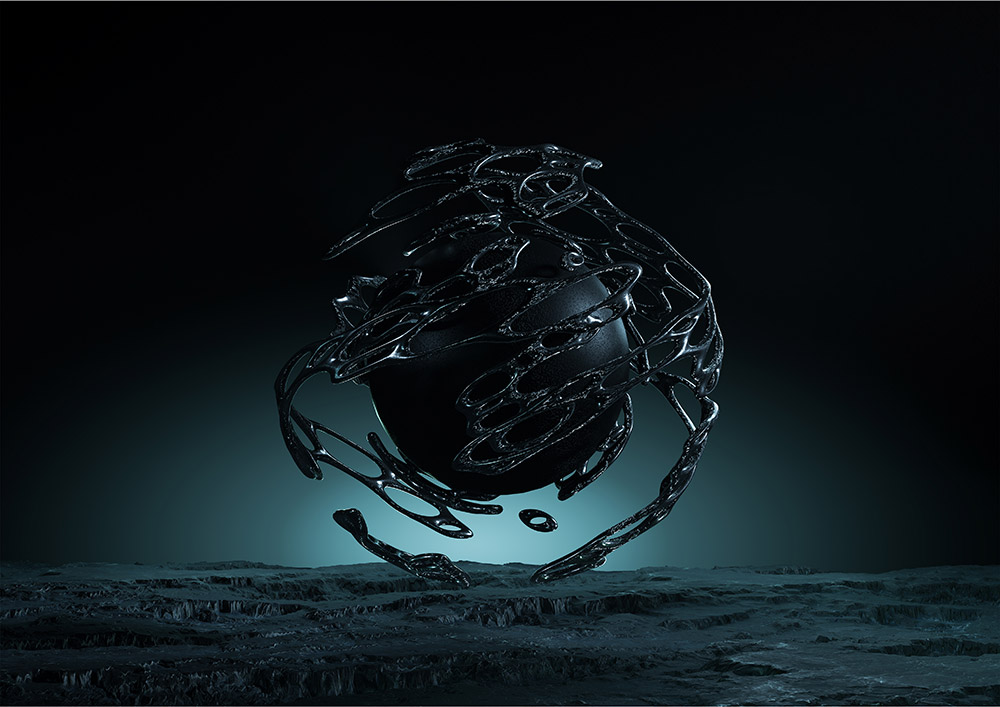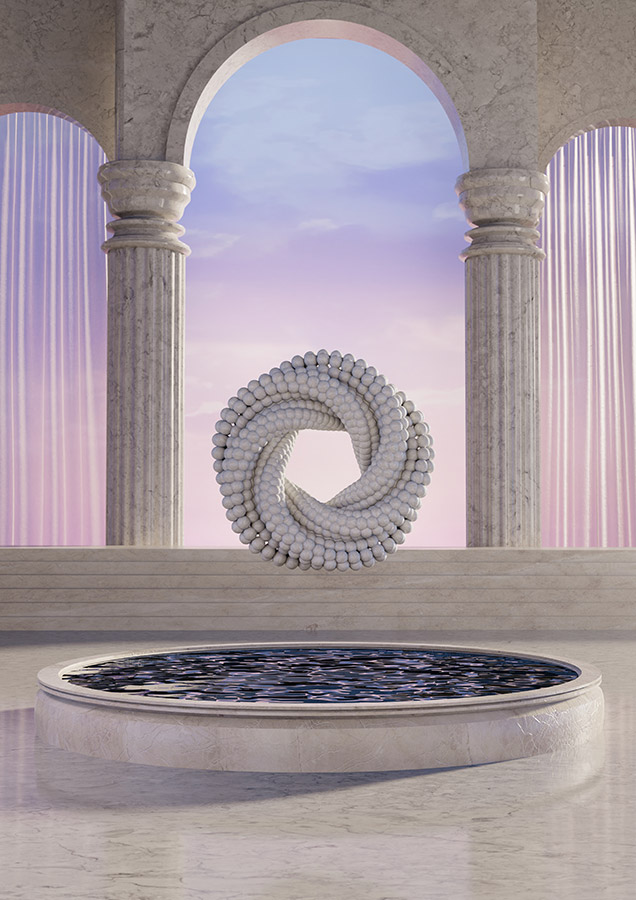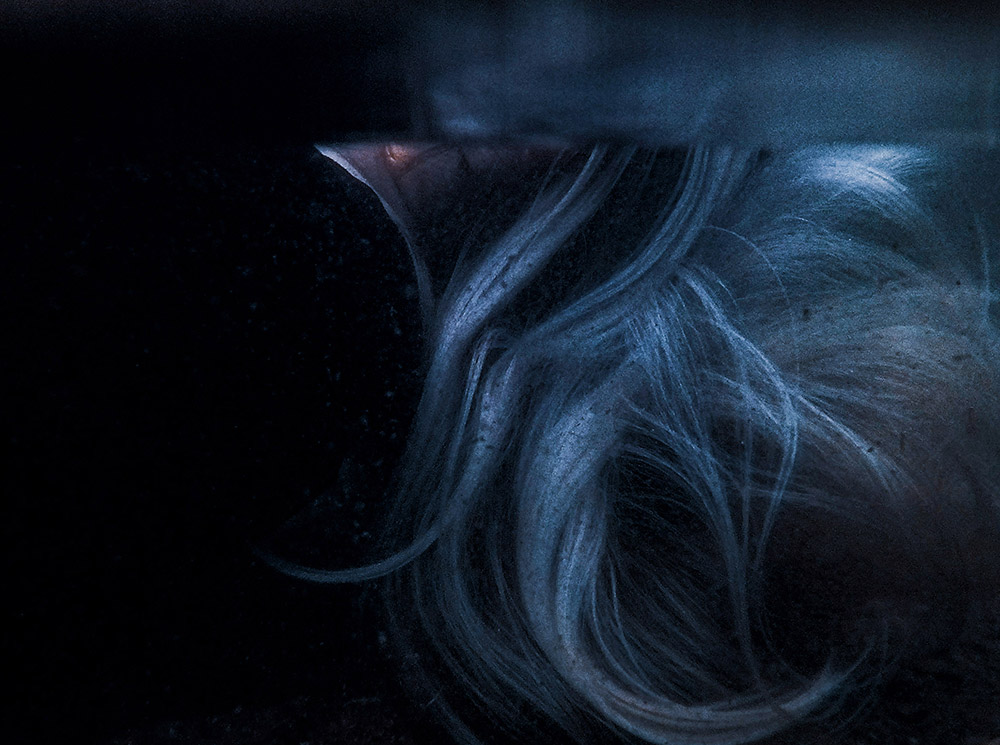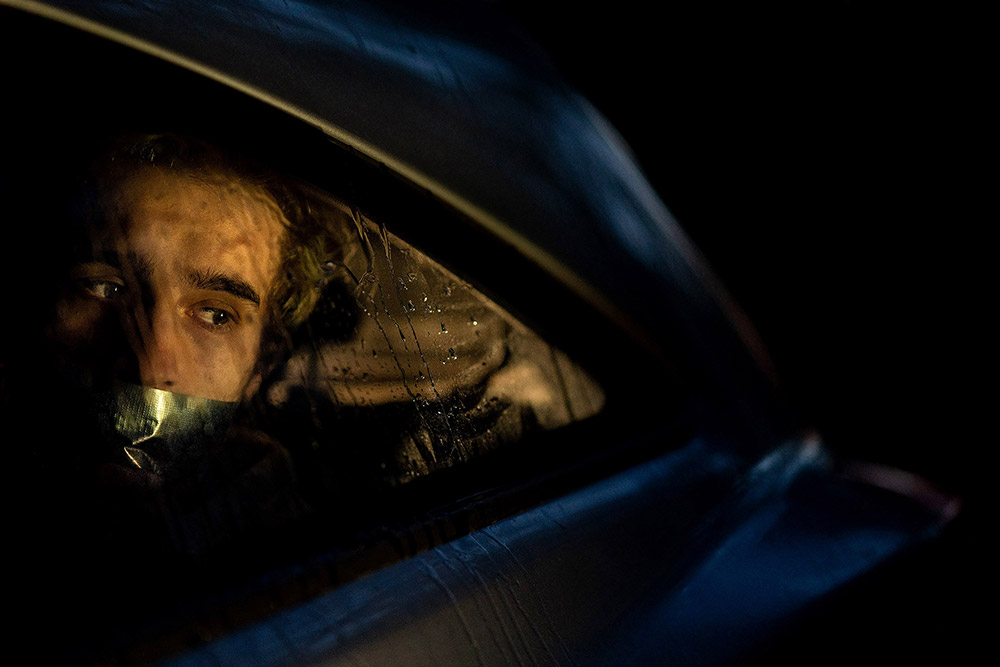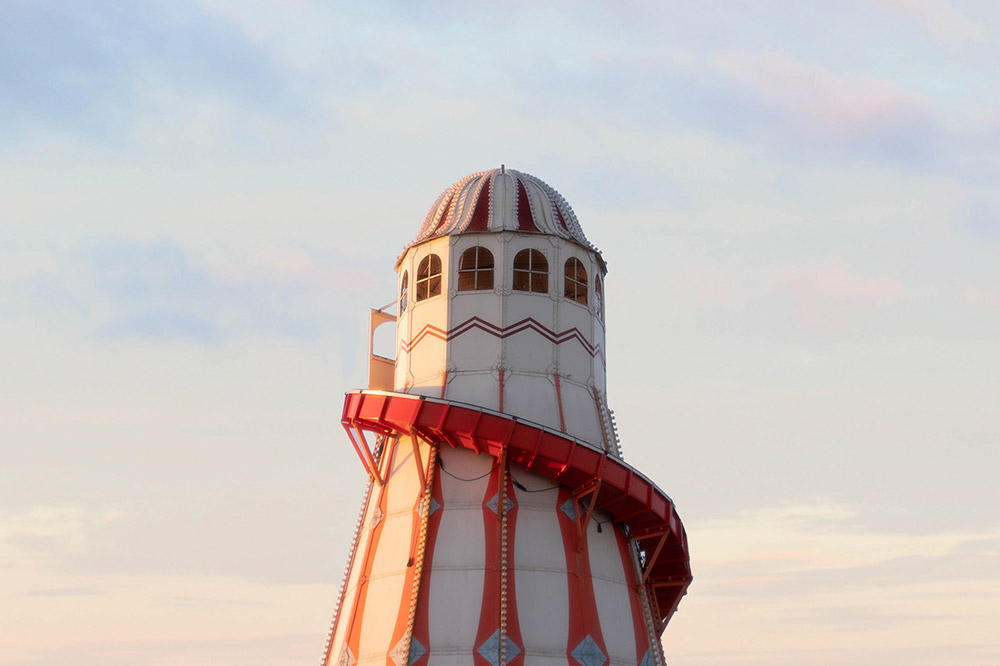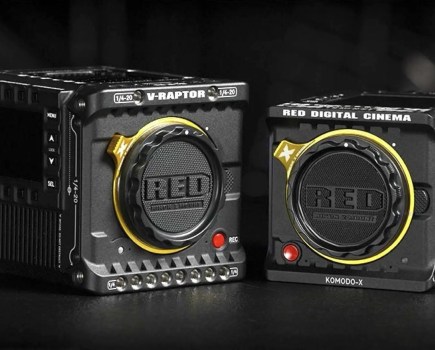Jessica Miller visits Beyond the Frame the graduate show by Final year BA (Hons) Photography students from Norwich University of the Arts. Below, the students share more about their projects and advice for those looking to get into photography.
Becca Simmons
Canon EOS 80D and Canon EOS 5D Mark III, 18-77mm and 24-70mm lenses.
Can you tell me about yourself and how you got into photography?
I have always been interested in art and have experimented with many different materials to work out which art form fits me best. I love to travel a lot and so photography became a great way to capture memories as well as showing places and people in a different light. I found that photography was the best media for me as I have been able to use it to the best of my ability.
Can you tell us more about your project?
This project focuses on Brutalist architecture and how I am able to change the perspective on how Brutalism is viewed. I have always been interested in architecture and focus on the types that are normally forgotten about. I am inspired by the different textures that the architecture creates and use positive light to highlight this. I also like to show the many patterns and shapes that Brualtlism has to offer.
How did you select the photographs for your show?
The two photographs displayed at the show were chosen by three people who are a part of the creative industry. They gave tips on how to improve the images further so that they were perfect for the show.
What are your future plans?
I am planning to do some travelling before focusing on my career. I would like to go into social media and help content creators to run their account. On the side, I will also continue to photograph architecture around the world.
Do you have any tips for others wanting to get into or study photography?
- If there is a genre of photography you are interested in, make sure that you focus on that and use it to explore other avenues.
Is there anything else you would like to tell us about yourself or your work?
I also run my own small business on Etsy which has given me an insight on when to post and to keep up to date with the newest trends. It is called The Crystal Room.
Charlotte Hutchins
@charlotte_hutchins_photography
Canon EOS 90D with a 30-185 mm lens (second and last image), the first image was taken using a Canon EOS 5D Mark III with a 24-70 mm lens. I used natural light on all of my photoshoots and shot on location.
Can you tell me about yourself and how you got into photography?
My journey with photography so far as is follows. I was about thirteen when I got an iPad for Christmas, which I loved taking photos on. I took it with me most times I left the house, even just to go on a walk and I loved to photograph nature and animals. We had many dogs in the family home growing up, and I believe this is where I got my love for dogs from, I would enjoy taking photos of them on my iPad.
I decided to study photography in GCSE, then I got a bridge camera from my parents and this is when I started taking photography more seriously. I studied photography in college where I explored a range of different genres of photography, though my passion always came back to photographing pets. I went on to study photography at university too, which has lead me to possibilities which I wouldn’t have thought I was capable of, such as interacting with photographers working in the industry, exhibiting my work and meeting new people through my photography projects.

Philippa and Breagh. Breagh the cockapoodle enjoying a quiet moment on the bench with her owner. Image: Charlotte Hutchins
Can you tell us more about your project?
My recent project is about documenting the relationship between pet dogs and humans. I am originally from Lincolnshire, so when I came to Norwich for university, I only knew the student friends I made, who were also not from Norwich. As I knew nobody with pets in Norwich, I had to reach out to the public to find local dog owners to take part in my project, and I did this by walking around parks and scouting for people and dogs I could photograph. I would approach them and have a nice chat before we took some photos. I also used social media, joining local dog owner Facebook pages and posting about my project on there brought me an amazing response of many people wanting to be involved in the project.
The backstory of my project comes from my memories of growing up with pets in the household. I have always had dogs in the family home and grew up around them, and it was coming to university that made me realise that I missed having my own dog around for company. I became fascinated with the meaning of a pet’s place in an individual’s life and what that pet means to them, and so I began to photograph other people with their dogs to further explore this. The comfort and joy that a pet can bring to someone’s life is something which I aimed to show within my images. I was inspired by the following artists: Mutley’s Snaps, Pet Stories Photography, Olivia Brabbs.
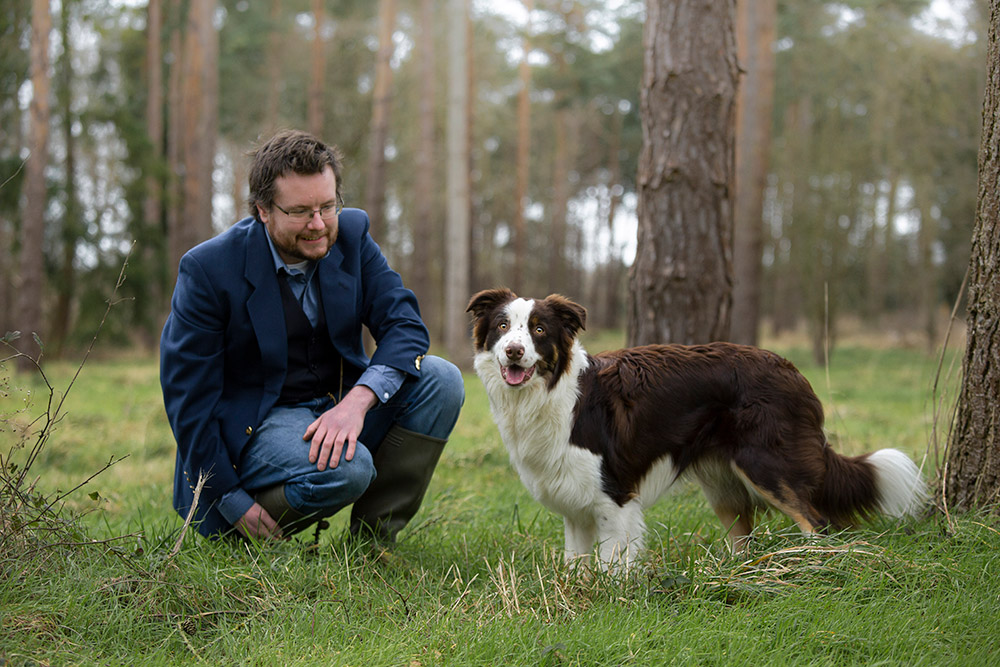
Jason and Gus. “I feel like I have a special bond with all of my grandad’s dogs, however I have the strongest connection with Gus the young puppy, I think this is due to the amount of time I have looked after him” – Jason. Image: Charlotte Hutchins
How did you select the photographs for your show?
The photos selected for the show were chosen by professionals in in the industry. I had narrowed down which images I wanted to consider for the show before presenting them to the panel. The strongest images showed the friendship and bond between owner and pet, revealing the pets’ individual personalities, and included an interaction between them and their owner.
What are your future plans?
My future plans are to continue photography where and when I can. I have recently photographed and been a photography assistant at a few weddings which I greatly enjoyed and would be open to doing again. I would love to eventually do photography as a part time job, doing pet photography.

Carol and Manchester Terriers. “I like to teach them things and there is nothing like that light bulb moment when they get it. I love it when they all come to snuggle with me on the sofa and I like watching them play and have fun‚” – Carol. Image: Charlotte Hutchins
Do you have any tips for others wanting to get into or study photography?
- Experimenting is key! Whether it be exploring different genres or how you photograph the subject, experimenting and testing out different things will open up new possibilities and lead you to find what you enjoy most! Experimenting is the key to creativity.
- Don’t be afraid to reach out and talk to people about your work. It may seem really daunting to ring or go up to and talk to somebody you don’t know, but the likelihood is that most people are willing to listen and help out, and even if you are told no, it doesn’t mean that the next person will say the same. This was one of the biggest barriers I challenged myself with and overcame on many occasions. To this day I am still in contact with the people I met through my recent projects photographing pets, and it is also a great way to form connections online too.
- Let yourself enjoy creating images. One of the biggest things I took from studying photography was to let myself enjoy creating art outside of expectations or thinking of what others would like. Take photos for the fun of it sometimes, take photos for you sometimes, not everything you produce needs to be directed at an audience.
Christopher Gardiner
Can you tell me about yourself and how you got into photography?
I became interested in photography in high school when I wanted an excuse to be creative and go out more often. I borrowed my dads camera and became obsessed. I started out mainly photographing plants and landscapes but quickly moved on to portraiture when I was able to get access to studio lighting equipment.
Can you tell us more about your project?
My current project is a little different from the ones I’ve done in the past (a lot of still-life and documentary photography) since this project is CG based. In the third year of my photography degree, I started thinking of concepts that were meant to blur reality in some way and weren’t entirely possible for me to create before the end of the course, so I decided to learn 3D modelling. It just made sense to learn how to use Blender and incorporate 3D design into my work as experimentation.
I quickly saw Blender as similar to an empty photography studio, in the ways of adding a camera, lighting and subject and having control over the depth of field and framing of a shot. The only difference was that I was able to create the subject from scratch, even entirely new worlds, leading to my current project ‘Utopia’. Utopia as a series is an attempt to try and blur the lines between real and Computer based imagery but is also a visualisation of places I daydream about. For me, CG and photography have ended up working hand in hand to create something completely new and I am now working on adding moving image to the series.
How did you choose which photographs would be included in your show?
For the image selections, we were lucky enough to have a final selection panel made up of guests from within the photography industry, who helped us narrow down the work we had selected ourselves. I took my favourite pieces from the past 2 years of study that I thought might work well and then pitched them to the panel, which allowed us to narrow down the selection for the prints in the show. After that, I just had to refine the images with any final retouching.
What are your future plans?
My future plans are to continue pursuing photography and CG in any way possible. I will be continuing ‘Utopia’ for now, while building a portfolio. I’m hoping to get the opportunity to work within CG or retouching eventually, maybe in advertising, as they are both creative areas that I really love. It would also be nice to to travel for a while and document the places I get to visit.
Do you have any advice or top tips for others wanting to get into photography/wanting to study photography?
Trying a bit of everything within photography is a great idea when starting out, switching genres, experimenting with lighting techniques and retouching, learning a bit of moving image, it all helps when finding out what really works for your practice and can lead to new interests and opportunities that weren’t originally considered. I think it’s a great subject to study because it teaches to analyse how the world is viewed through a lens and what your own view is saying. It also provides a technical skillset that can be applied to so many areas within the creative industries, not strictly photography.
Harriet Atenia
07899673344
Canon EOS 90D and 35-70mm wide angle lens, Sony A7III and 85mm wide angle lens, Nanlite Litolite 5c and Neewer 2.4G LED video lights.
Can you tell me about yourself and how you got into photography?
As an individual I’ve always enjoyed preserving memories, freezing moments in time. It opened up my eyes to how as a creative I have the power in choosing what art I put out into the world. Revealing my perspective to audiences, and the manipulation of the ‘point of view’ has always engaged me.
This was a catalyst in fuelling my passion for photography and storytelling, delving into how visual artists convey the narrative of escapism. I’ve been majorly influenced by the ‘’uses and gratification theory’’ discovered in 1970 by psychologists Blumer and Kratz, exploring how our basic needs can be gratified and triggered through visual media.
This concept gave me an insight into why society seeks visual media to escape, whilst also allowing me to reflect on my personal life, and how I choose to escape through photography, film and other forms of visual media; giving me an insight into how I can translate detached depictions of reality throughout my practice. Driven by this newfound curiosity, I knew as a photographer I wanted to explore relationships and narratives within fictional worlds with a ‘filmic’ aesthetic.
Can you tell us more about your project?
Throughout this series I have been influenced by the work of director Christopher Nolan, who utilises the camera as a tool to assemble complex and intricate plots, presenting them in a way that challenges the audience’s intelligence outside reality. Combining techniques and concepts often found throughout cinema, the aim was to create imagery with a “filmic” aesthetic, blurring the lines between photography and cinematography.
Engaging with open ended, non-linear fictional narratives, collaborating with both the creator of ‘The True Crime Files’ blog and podcast, Christine Penhale and author Andrew Hook to create a fictional murder file, and story. I was influenced by the rising numbers in female murder cases, and kidnappings, like that seen in 2021, where the investigation involving 33-year-old female, Sarah Everard took over the media.
This allowed me to alter the perception of how audiences can view this series and subject matter overall. Capturing a feeling of movement and progression regarding the narrative, I also wanted to be cohesive in the underlying colour palette, using colour and contrast to elicit relevant emotions to give the viewer feelings of fear, loss, and isolation. As well as enhancing the injuries seen on the victim, aiding the fatal secret behind her death.
By further experimenting with colours such as orange and blue, it provided a familiar ‘filmic’ visual aesthetic, typically used within modern day cinema, as well as giving the audience a warmer contrast in comparison to the cold and isolated blue tones that dominated this project.
How did you choose which photographs would be included in your show?
The subject matter of the two images included in the show involved a narrative surrounding an unsolved female murder investigation I wanted to evoke an emotive reaction from my audiences. At first glance some of the images appear violent and gory, potentially making the viewer uncomfortable, thus making them pause and reflect on the work, questioning the overall narrative of the image, and how the female subject got to where she was within the images. This moment of reflection is what I aimed to get from viewers at the show, encouraging this conversation between photographer and audience.
What are your future plans?
My intention is to progress into an assisting role on a film or TV set, with an aim to also specialise in unit stills photography and cinematography on large global productions. I have a huge desire to learn, collaborate and test my adaptability as a creative, exploring new ways of storytelling outside of just photography. Working with established film and TV production companies such as Warner Brothers, Paramount, Pinewood, Netflix, ITV and the BBC. A long-term goal is to make strides in the development of my moving image work, transitioning into the role of a director, or director of photography (DOP) building on the rising network of prevalent women within the film and TV industry.
Do you have any advice or top tips for others wanting to get into photography/wanting to study photography?
- I encourage any creatives wanting to get into photography to collaborate, and not just with other photographic practitioners but specialists outside your comfort zones, such as architects, writers, scientists and filmmakers. Collaboration allows you to develop team working, communication, time-management skills, and most importantly the crossover of creative minds is extremely rewarding as a practitioner and allowed me to develop my work in new and exciting ways.
- Experimentation is key. One of the best ways to learn and adapt as a creative is by making mistakes, and my time at university allowed for that. It allows you to reflect and develop on your work, and it can potentially take you down an unexpected avenue.
- Photograph what you are passionate about, explore a subject that makes you happy and keeps you engaged. This will result in a portfolio that you are proud of and will make you excited and determined to show and discuss within the industry, and this passion will come across to others.
- Printing out work regularly allows for a tangible reflection on the colours, tones and brightness of your images, as more often than not your image will look completely different on screen to when it is printed out, meaning you can adapt and experiment with editing techniques, this is also useful for when you begin to put work in publications and exhibitions.
Jason Stirland
For one of the images in this project I used my Nikon D810 and Nikkor 24-70mm lens, this is something I want to explore more with as the details and style of the image is very different, but for most of the images here I have used a LiDAR scanner, while I was looking for a cheap one I also was looking for a phone upgrade at the time and decided to see what the iPhone 13 Pro could create.
Software is equally important for this type of work, to create the visual representation I want, therefore I use Meshroom, Metashape, Cloud Compare, Unreal Engine and now Unity. Each of these programmes either allows me to create the style I want or to work on animations and movements.
Can you tell me about yourself and how you got into photography?
I am a photographer and artist based in Norfolk and currently exploring the vast world of Blender and CGI, using a combination of innovative technologies, and creating powerful, bold images, I push the boundaries of our understanding of photography and how we interact with images today. Using technology, I show my work in nostalgia and memory to provide different immersive experiences using a new and exciting way to visually show my work through the use of AR (augmented reality) and VR (virtual reality) to provide a stronger connection between the work and emotions.
I got into photography through my grandma, she would always be the one taking images of everything to keep and hold onto special moments, as I grew up I developed a love for technology and later photography, this would allow me to combine both of my passions into what I’m able to create today.

No Running. This is a phrase I would often hear in the summer, running from room to room and through the forbidden room to go to the pool, the feeling of excitement to go swimming making me a little hyper before the sudden realisation that the pool is not heated, dipping my toes into the water I would have to build up the courage before taking the plunge into the chilled water. Image: Jason Stirland
Can you tell us more about your project?
Using LiDAR* technology traditionally used by architects to measure three-dimensional distances within buildings I attempt to explore and create my memories both old and new. Within this series of work, I have revisited places with deep personal significance from my childhood through the creation of 3D environments I am able to explore within virtual and augmented reality. I invite you to join me on a trip through my childhood memories through my own eyes and personal experiences that have led me to where I am now.
During this project I wanted to be able to connect with places again, during my experiences of watching videos recorded by family when I was younger, I have always struggled with the recollection of important memories from my childhood whether it be family photos or videos. I never really felt like I was able to recollect the memory space and environment clearly, however as technology has become more powerful and accessible, I’m able to experiment with recreating places within a 3D world. Using technology in my work allows me to connect with my past in a much more immersive and personal way.
* a method for determining ranges (variable distance) by targeting an object or a surface with a laser and measuring the time for the reflected light to return to the receiver. It can also be used to make digital 3-D representations of areas.
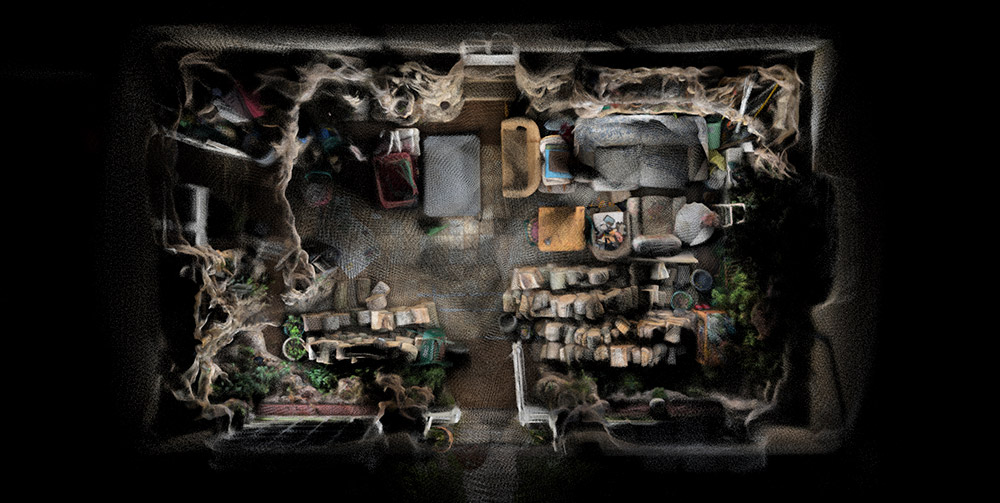
Orangery. As the house creaks in the wind at night I find myself investigating, trying to find out where the noise is coming from, being worried about what it could be but also feeling safe with the dogs beside me, the Irish wolfhounds were as tall as I, wandering into the orangery with only the moonlight illuminating the room and surrounds I was always afraid of seeing someone the other side of the glass windows. Image: Jason Stirland
How did you choose which photographs would be included in your show?
The university helped us a lot with this which was great, we had a selection panel of industry professionals that would help us curate what images would be selected, this would help with the overall consistency of the exhibition, at first I was planning try and show the images in virtual reality, however after talking with the professionals and my course leader we all agreed that a print would be best.
What are your future plans?
My future plans are to get some work experience now, I’m currently looking for professionals that I can benefit from their experiences and further my own practice, either from a business perspective or technical. I’m fortunate to have won the EIZO student awards as part of the reward I will now have an EIZO colour edge monitor and work placement and mentorship with the judge who selected my work as one of the three winners.
I’ve already started to experiment more with memories as this project develops further, I’ve started to look into old VHS homemade videos that were taken in my childhood to create a 3D environment that you are able to revisit within virtual reality, the reason behind this is that I have always had a disconnection from the place in the video as you can only relive these experiences on a 2D screen, but this is no longer the case.

Deep In Thought. Grandma and I will often sit at the table and recall memories that we remember, either from my childhood or hers, one that we spoke about recently was when my cousin and I came over for the night, before we went to bed we had a play fight, I remember my grandma having a changing screen and being thrown into it from the bed, a short moment later I heard a thud as my cousin crashed on top of me after being thrown in the same place.
Image: Jason Stirland
Do you have any advice or top tips for others wanting to get into photography/wanting to study photography?
I think some of the best advice I have been given for my work is to keep going, don’t take the easy way, experiment, and believe in yourself, if you start a project and you know how it will end then you aren’t pushing yourself enough. At the start of my final term, I struggled to see the end result and was given this advice.
Is there anything else you would like to tell us about yourself or your work?
I was in the Canon Student Development Programme (Top 100) didn’t make top 30 unfortunately, EIZO Student Award Winner, The Association of Photographers (AOP) Student Awards Finalist for the places category, and won the D&AD New Blood: The Portfolios Winner.
I’m always happy to talk about my work, so if you would like to know anything else, please do not hesitate to contact or follow me on my social media.
Liz Ferguson – Dreamland
Canon EOS 5D Mark IV and Zoom Lens, soft blur lens filter to soften images.
Can you tell me about yourself and how you got into photography?
I’m 21 and have recently graduated from Norwich University of the Arts with a BA Honours in photography. I have always been a creative person as a pose to academic during school, when I was in year 10 I received my first camera for my birthday and ever since then I have been in love with photography.
Can you tell us more about your project?
My current project ‘Dreamland’ focuses on creating imagery to trigger certain controlled memories of the English coast to influence the viewers to want to revisit the seaside locations from their childhood, this will in turn help improve the decline in tourism the coast has been impacted by. The initial motivator was the decline in tourism where instead of highlighting the negative issues I wanted to make imagery that was positive and nostalgic with a romantic and emotive set of visuals.
To allow the outcomes and imagery to be more focused I have decided to solely focus on two locations; Great Yarmouth and Clacton. I am focusing on these two beaches because they both have one main thing in common; they are both locations with piers that rely on tourism to produce an income. Linking back to my initial motivator for this project.
These locations directly link to the decline in tourism and the negative impact it has on these locations, I have personal memories with both of these locations associated with feeling of nostalgia so I can bring an interesting perspective to the images; returning puts me in a unique position. I can be subjective and objective, an insider and an outsider.
When researching bias nostalgia I knew it was something I wanted to further push in my imagery, my outcomes were biased in a sense because I was making the locations out to be better than they perhaps are based on my memories. I digitally manipulated the images by removing areas of the images, I did this to push bias nostalgia more in my outcomes. To further show the themes I had focused on through my work I experimented with composition and framing to further change the perspective of a familiar place leaving the viewer curious.
How did you choose which photographs would be included in your show?
The process of choosing what photographs to include in my final year showcase was a long process. To gain a better understanding of what photographs were the strongest and represented the themes I have explored most successfully I gained feedback from creative industry professionals. The feedback allowed me to make informed decisions and ensured the photographs I chose were up to the industry standard.
What are your future plans?
Initially after graduation I am going interrailing around Europe with the intention to continue to develop my portfolio and work on personal projects that I am passionate about. My current long-term plans are to become a ‘Creative’ who can contribute to a number of different roles within a creative team.
Do you have any advice or top tips for others wanting to get into photography/wanting to study photography?
My main advice for anyone wanting to get into photography is focus on creating work that is important to you, it will give your work a deeper meaning and will in turn elevate your work from others.
BA (Hons) Photography at Norwich University of the Arts
Find out more about studying the BA (Hons) Photography Course at Norwich University of the Arts.
See more student work here:
Behind the scenes of Middlesex summer exhibition
Westminster graduates demonstrate resilience in degree show
Falmouth students share diverse techniques in Gweles exhibition
UWE students share first exhibition post-pandemic
University of Gloucestershire students share new perspectives at photojournalism show
Middleman: the degree show by University of Portsmouth
Birmingham City students: elevating into the photographic industry

